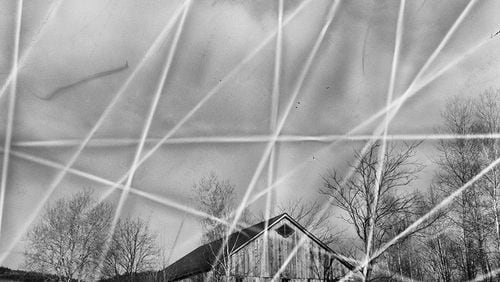Belief in something beyond what you can see is the idea at the core of the Zuckerman Museum of Art group show “Medium.”
The exhibit focuses on connections between our world and the afterlife. But the effort to reveal a reality beyond lived perception extends beyond the supernatural in “Medium.” It could be said to be every artist’s mission. Because like a psychic or medium facilitating communication with another reality, artists strive to show viewers an experience or a vantage beyond the familiar.
It’s an idea at work in Dan R. Talley’s “Seeing Through Psychics” series on view in “Medium.” Photographs of household objects — a sink or a beautifully carved piece of scrolled woodwork — become portals to other experiences. Next to images of those items, Talley places a text panel in which a psychic or medium describes the layers of grief and longing and secret human histories contained in those objects.
Look closely, much of the work in “Medium” suggests, and history speaks to us. One of the most powerful and resonant themes in “Medium” is the idea that history is a tangible reality outside of our immediate discerning. It can speak to us, yes. But we have to agree to listen.
That notion, that we must surrender to a reality beyond our immediate perception, is teased out in a stunning Carrie Mae Weems video piece that makes up for much of the less compelling work in the show. If you visit “Medium” for no other reason, go to experience Weems’ remarkable work “Lincoln, Lonnie and Me: A Story in 5 Parts” (2012). A deeply unsettling excavation of history housed behind black curtains in a back gallery of the Zuckerman, Weems’ piece is inspired by a 19th century carnival illusion, “Pepper’s Ghost,” an invention that gives the sensation of a ghostly apparition appearing before the audience’s eyes.
Accompanied by an atmospheric soundtrack of old ragtime and pop music, in “Lincoln, Lonnie and Me,” visitors sit on benches behind a stanchion and watch an array of spectral figures appear in the black ether between two parted red velvet curtains: entertainers, “Playboy” bunnies, a boxer, a minstrel. From the “Gettysburg Address” to a reenactment of the JFK motorcade, American history fades in and out. The work is utterly haunting, a theatrical procession of the more melancholy strains of American history, which, in the eyes of many African Americans, including Weems, is marked by racism, violence and willful blindness to injustice.
Not all of the artists in “Medium” are as successful or as evocative as Weems. Some of the work can feel decidedly off-base, like P. Seth Thompson’s abstracted television images from the 1982 movie “Poltergeist” or from the 1987 media sensation of 18-month-old “well baby” Jessica McClure. Even a noble effort to excavate racist history in an installation by collaborators T. Land and George Long suffers from a weak installation and some unsatisfying visuals. Alongside more conceptual artwork, historical documents are used throughout “Medium” to give the show some gravitas. More an interesting oddity unearthed by the curators than relevant to the show’s themes, musical recordings created on old X-rays in Soviet-era Russia to skirt censorship document a fascinating historical reality. But some of the eeriest documents in the exhibition are devoted to University of West Georgia professor William G. Roll’s lifelong study of the paranormal. Investigators allowed Roll to enlist psychics to help solve the murders of 28 children during the 1979-1981 Atlanta child murders case. And while the results of their tips were inconclusive, there’s no shaking the unsettling shudder of real suffering hidden within these cold scientific records.
“Medium”
Through Dec. 3. 10 a.m.-5 p.m., Tuesdays-Saturdays; noon-5 p.m., Sundays. Free. Zuckerman Museum of Art, Kennesaw State University, 492 Prillaman Way, Kennesaw. 470-578-3223. zuckerman.kennesaw.edu
Bottom line: A mix of conceptual artwork and historical documents add up to a show partly insightful and partly floundering in its examination of the connection between the afterlife and the present.
About the Author






